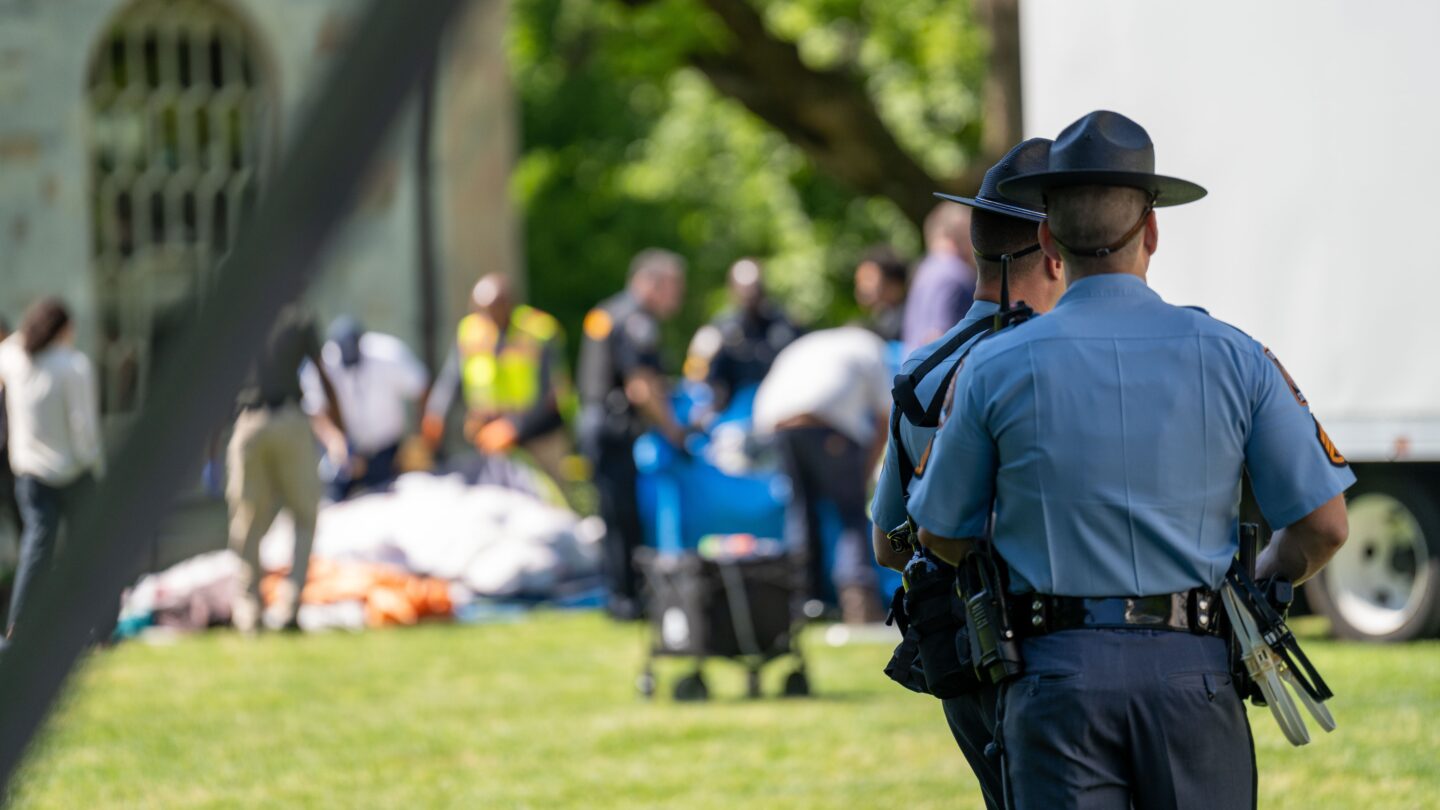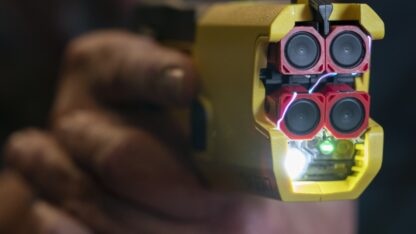Georgia requires fewer hours of basic training for law enforcement officers than any state but Hawaii. With this training, new officers enter unpredictable and dangerous situations where they must make quick decisions under stress.
Even though they had more than five years on the Columbus police force, that’s what Officer Michael Aguilar and his partner faced in the pre-dawn hours of Jan. 9, 2017.
Hector Arreola, 30, had called police twice after 3:40 a.m., fearing he was being followed and his mother was in danger. When Aguilar and Officer Brian Dudley showed up at Arreola’s mother’s house to check on her safety, they found him outside.
Aguilar thought Arreola might be having a mental health crisis and called emergency medical services. He tried to reassure Arreola. When Arreola ran into a neighbor’s yard, the officers gave him space.
“The last thing I wanted to do was arrest Hector Arreola,” Aguilar later said in a deposition for a lawsuit filed by Arreola’s family.
But when Arreola knocked on the neighbor’s door, the officers arrested him for disorderly conduct, handcuffed him and held him facedown, with Aguilar sitting on Arreola’s lower back. Body-camera video showed Arreola screamed at least 13 times that he couldn’t breathe.
He suffered cardiac arrest and died the next day at the hospital.
Arreola’s death initially was ruled an accident due to methamphetamines. But in 2020, an amended autopsy reclassified it as a homicide caused by “sudden cardiac death following (a) struggle with law enforcement including prone position restraint complicating acute methamphetamine toxicity.”
In 2021, the city of Columbus agreed to pay Arreola’s family $500,000 to settle the lawsuit.
For Arreola’s father, Rodrigo Arreola, justice remains elusive.
“I served 22 years in the Army, and I served my country. I served for all of those who haven’t served. I served for my family. I served for other families,” he said in an interview. “Where’s my justice?”
As part of a national investigation that found more than 1,000 deaths after officers used physical force or weapons that are not supposed to be lethal, reporters for the Howard Center for Investigative Journalism at the University of Maryland focused on Georgia and its blend of urban and rural communities, examining records to understand how deaths occurred.
The reporting, done in collaboration with The Associated Press and covering 2012 through 2021, identified 30 people who died in Georgia after police used “less-lethal force.” In all, 26 of these non-shooting deaths involved police restraining people facedown, in what is known as prone position. In more than 80% of prone restraint cases, police reports, video or other documents show officers applied body weight or pressure on the person’s back or neck.
The federal wrongful death lawsuit filed by Arreola’s family revealed Aguilar and Dudley had received use-of-force instruction by the Columbus Police Department staff that contradicted the agency’s own policies.
As of six years before Arreola’s death, Georgia’s statewide basic training program required that officers learn to be aware of positional asphyxia, which occurs when compression of a person’s torso from weight on their back or neck obstructs their breathing. Obesity, heart conditions and drug use increase vulnerability.
The solution is to move someone off their chest once they are handcuffed, either rolling them to their side or sitting them up.
Aguilar said in a deposition for the lawsuit that it was necessary for him, Dudley and a third officer to keep their body weight on Arreola’s back after he was handcuffed because of the intensity of his resistance.
“And by him talking and being able to say, ‘I can’t breathe,’ multiple times indicated to me that he was breathing just fine,” Aguilar said. “Because if he had enough breath to say it, he had enough breath to breathe.”
Police experts say that’s a dangerous misconception. To speak, air must only reach the throat. To inhale breath, it must travel all the way into the lungs.
When Lt. Tim Wynn, the department’s training director, was asked in his deposition if the officers had been trained to take yelling and screaming as an indication a suspect was breathing, Wynn said, “I agree with that.”
Wynn also said officers were taught it was appropriate to continue putting pressure on a struggling suspect’s back after they were handcuffed. “That would be along the guidelines of what we teach,” he said.
Columbus Chief of Police Richard Boren disputed both men in his own deposition. “That’s not taught with the Columbus Police Department,” Boren said.
Boren said that if someone complained they couldn’t breathe, the city’s training in 2016 and 2017 called for officers to monitor the person and, “once an individual was in compliance, he would be rolled over and sat up and we would also contact EMS and have EMS in route to take care of whatever medical issue could be there.”
Police training in Georgia is a patchwork. The state set a basic training minimum of 408 hours for all officers in 2006, and hasn’t changed it since.
“We’re turning people loose on the public that have 408 hours of training,” said Louis Dekmar, the longtime LaGrange police chief who retired in February after 50 years in Georgia law enforcement at the state and local level. With that training officers have “the ability to remove their children, deprive them of liberty, apply force if they resist,” he said. “And we do that with 408 hours? Are you kidding?”
Individual departments can require more training and can send officers for additional state training.
But Glyn Corbitt, who teaches a crisis intervention course at the Georgia Public Safety Training Center, said not all agencies can afford to do that. “If you got a small agency,” he said, “and there’s only six officers — and that’s including the chief — having somebody gone 40 hours might be almost impossible.”
Sgt. Adam Celinski worked in one of those small departments in southwest Georgia the night he got a call about a stranger pounding on the front door of a house in Sylvester on Oct. 18, 2016.
Celinski found Terrell “Al” Clark, who said he was high on “powder,” outside the house. The officer handcuffed Clark, 47. When he started struggling, Celinski put Clark facedown on the ground with his hands behind him and Celinski’s knee on his back.
As Celinski and another officer waited for emergency medical services to arrive, Clark’s breathing got shallow and he stopped responding. He was declared dead at the hospital.
An autopsy determined Clark’s death was an accident from “acute cocaine toxicity in conjunction with hypertensive cardiovascular disease.”
Celinski, now a lieutenant in the drug investigation division of the Worth County Sheriff’s Office, told the Howard Center that sitting Clark up “probably would have helped the situation.”
While the Georgia Public Safety Training Center could not document exactly what Celinski was taught as a recruit in 2013, its leader of basic training said that positional asphyxia was part of his curriculum, and instructors had to certify that graduates understood it.
Celinski said that, as he learned to be an officer, there “wasn’t hardly any” training on the dangers of keeping suspects, especially those on drugs, facedown. “There really just wasn’t,” he said.
Contributing from the Howard Center were Winter Hawk, Abbi Ross, Paige Maizes, Aiesha Solomon, Nyrene Monforte, Evan Hecht, Mario Morais and Angelique Gingras; Martha Bellisle from The Associated Press also contributed.









